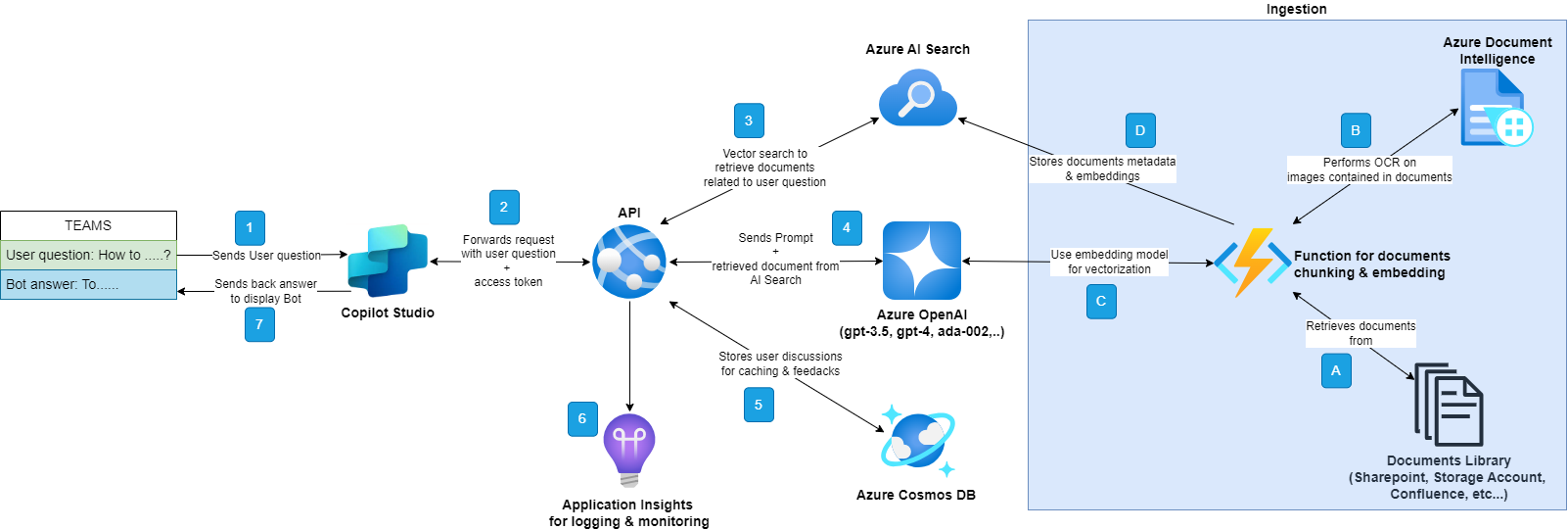Welcome to the RAG from Zero to Hero project!
This project aims to provide a comprehensive guide to become proficient in RAG (Retrieval Augmented Geneation) system.
In this guide, you will find step-by-step instructions, examples, and best practices for using RAG in Azure.
RAG is a powerful model that combines retrieval and generation capabilities to generate high-quality responses to user queries based on your own data. Here is the architecture of the RAG components that will be built in this guide:

This diagram illustrates the workflow of a RAG system using Azure AI Services and Azure OpenAI models. The process starts with a user question and ends with providing an answer, going through various processing and integration stages. Here is a step-by-step explanation of the process:
-
Teams: The conversation starts in Teams, where a user asks a question. The bot then sends the question to Copilot Studio.
-
Copilot Studio: It takes the user's question and transmits it via an API with an access token for authentication.
-
API: The request is sent to an API service that uses vector search to find relevant documents related to the user's question.
-
Azure AI Search: This sends the request to Azure AI Search, which performs a vector search to find the most relevant documents from a database of documents.
-
Azure OpenAI: An OpenAI model (such as GPT-3.5, GPT-4, ada-002, etc.) receives the retrieved documents and the user's question, then generates a response based on the information contained in those documents.
-
Azure Cosmos DB: An Azure database that stores user conversations for caching and feedback collection to improve the response system.
-
Application Insights: A monitoring and logging service to analyze the application's operation and optimize the user experience.
-
Response: The generated response is sent back to the user in Teams, completing the conversation cycle.
The diagram also shows a document ingestion process on the right side, indicating how documents are processed and stored in AI Search:
A. Documents Library: A library of documents that can include various sources such as SharePoint, storage accounts, Confluence, Web Pages, etc.
B. Azure Document Intelligence: A function that performs Optical Character Recognition (OCR) on images contained in the documents to convert the text into digital data.
C. Function for documents chunking & embedding: A function that processes documents by breaking them into smaller sections and using an embedding model for vectorization, making them ready for vector search.
D. Azure AI Search: This part stores the metadata of the documents and the embeddings, making them easier to retrieve during search.
The diagram depicts a complex workflow where each component has a specific role in facilitating information retrieval and generating accurate responses to user questions. It illustrates a deep integration of Azure services to build an interactive AI-based system that can be used directly from a messaging application such as Teams.
- Install VS Code with the following extensions:
- Polyglot Notebooks
- C# Dev Kit
- Bicep
- draw.io to display & modify the architecture diagrams
- Install az cli
- Install .NET 8.0 SDK
.azdo/: Contains CI/CD pipelines for Azure DevOps.data/: Data folders including PDFs such as benefit options, the employee handbook, and others.docs/: Folders for documentation and associated architecture diagrams and images, including the system architecture.infra/: Contains Bicep scripts for Azure infrastructure. It leverages Azure Verified Modules to ease modules development.notebooks/: Jupyter Notebooks.src/: Contains the project's source code in C# of the API and Function App.
You should deploy the Azure resources. The resources are defined in the infra folder using Bicep. Resources will be added as needed in the guide.
First, create an Azure Resource Group using az cli:
az group create --name myResourceGroup --location francecentralGo to infra folder and fill the main.bicepparam file with the necessary parameters. Then, deploy the main.bicep file to create the necessary resources:
az deployment group create --resource-group <myResourceGroup> --template-file main.bicep --parameters main.bicepparam